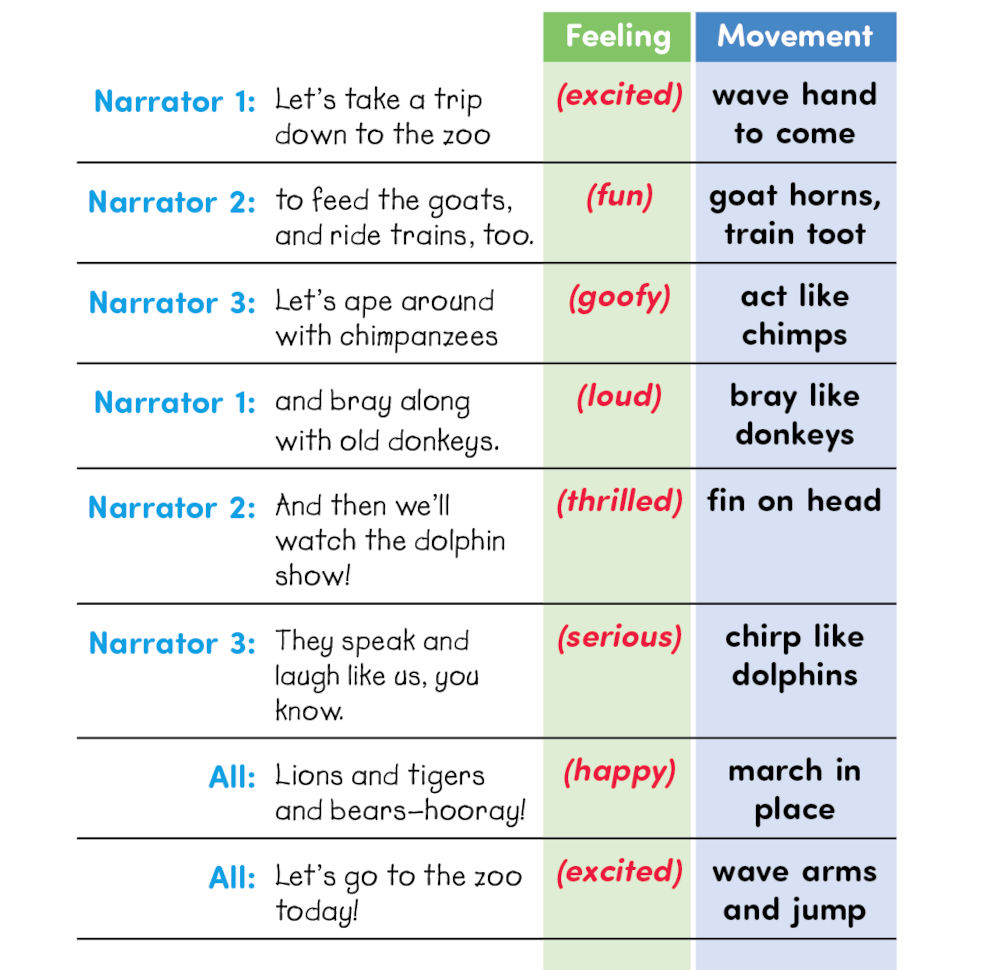WT 268
Page 268
Performing Poems
You’ve probably recited a poem before, reading it aloud for others to hear. But have you ever performed a poem? You act it out like a mini-play. Performing a poem makes it fun for you and for your audience.
Bringing It to Life
To perform a poem, you just need to find a poem you like, grab a few friends, divide up lines, and practice reading them. You also add movements that will make your classmates laugh and cheer. This chapter shows how.

WT 269
Page 269
Moving Poetry from Page to Stage
Follow these simple steps to prepare a poem and perform it for your class!
1. Form a team.
Get together with a few classmates. A good team size is two, three, or four performers.
2. Find poems to perform.
What poems have you or your teammates written? What poems have you read recently? Consider these. Also look through books of poems from your classroom, the library, or your home.
- Collect different types of poems. Collect funny ones, clever ones, and serious ones. Take turns reading the poems out loud.
- Choose the right poem. Poems that have a lot of action are easiest to perform, so consider those first. Poems that tell about feelings are harder, but you can perform one of those for a challenge.

WT 270
Page 270
3. Script the poem.
After you have chosen a poem, divide it into speaking parts. This is called scripting.
Original Poem 🟪 Let’s use Sara Kelly’s short poem “At the Zoo” to show you how to script. First read the poem, and then see how it was made into a script.
 © Thoughtful Learning 2025
© Thoughtful Learning 2025
At the Zoo
Let’s take a trip down to the zoo
to feed the goats, and rides trains, too!
Let’s ape around with chimpanzees
and bray along with old donkeys.
And then we’ll watch the dolphin show!
They speak and laugh like us, you know.
Lions and tigers and bears—hooray!
Let’s go to the zoo today!
Scripted Poem 🟪 To script your poem, you must decide on speaking parts. People, animals, or things can speak
Narrator 1: Let’s take a trip down to the zoo
Narrator 2: to feed the goats, and rides trains, too!
Narrator 3: Let’s ape around with chimpanzees
Narrator 1: and bray along with old donkeys.
Narrator 2: And then we’ll watch the dolphin show!
Narrator 3: They speak and laugh like us, you know.
All: Lions and tigers and bears—hooray!
All: Let’s go to the zoo today!

At the Zoo
Let’s take a trip down to the zoo
to feed the goats, and rides trains, too!
Let’s ape around with chimpanzees
and bray along with old donkeys.
And then we’ll watch the dolphin show!
They speak and laugh like us, you know.
Lions and tigers and bears—hooray!
Let’s go to the zoo today!
Narrator 1: Let’s take a trip down to the zoo
Narrator 2: to feed the goats, and rides trains, too!
Narrator 3: Let’s ape around with chimpanzees
Narrator 1: and bray along with old donkeys.
Narrator 2: And then we’ll watch the dolphin show!
Narrator 3: They speak and laugh like us, you know.
All: Lions and tigers and bears—hooray!
All: Let’s go to the zoo today!
WT 271
Page 271
4. Score the poem.
Next you must score the poem. That means naming feelings and movements for different lines of your script.

WT 272
Page 272
5. Perform your poem.
After you have scripted and scored your poem, start reading it out loud. Keep practicing until all team members know their lines. Then get ready to perform.
Tips for Performing
- Act confident. Stand straight. Don’t fidget.
- Face your audience. As a rule, don’t turn your back to the audience. Let them see your face!
- Introduce the poem and the poet. Before your performance, stand shoulder to shoulder. Together, announce the title of the poem and the poet’s name. Then move to your starting positions.
- Use your “outside” voices. This is the voice you’ll need so everyone can hear you! Remember to add the right feelings and movements when you speak.
- Take a bow. When your performance is over, pause for a moment, take a bow, and return to your seats.
 © Thoughtful Learning 2025
© Thoughtful Learning 2025

WT 273
Page 273
Encore! Encore!
Use Izaak Jones’s list poem for an encore (an additional performance). You and your team can add your own feelings and movements to the poem.

Things to Do
This year, I have a lot to do:
go to the park and make new friends,
help my neighbor get up her stairs,
plant a pumpkin and watch it grow,
take my dog Jasper for lots of walks,
brush my cat Reggie to get out the mats,
learn a hundred new things in school,
sing “Happy Birthday” 50-some times,
read about everything under the sun,
and tuck myself in when all of it’s done.
—Izaak Jones